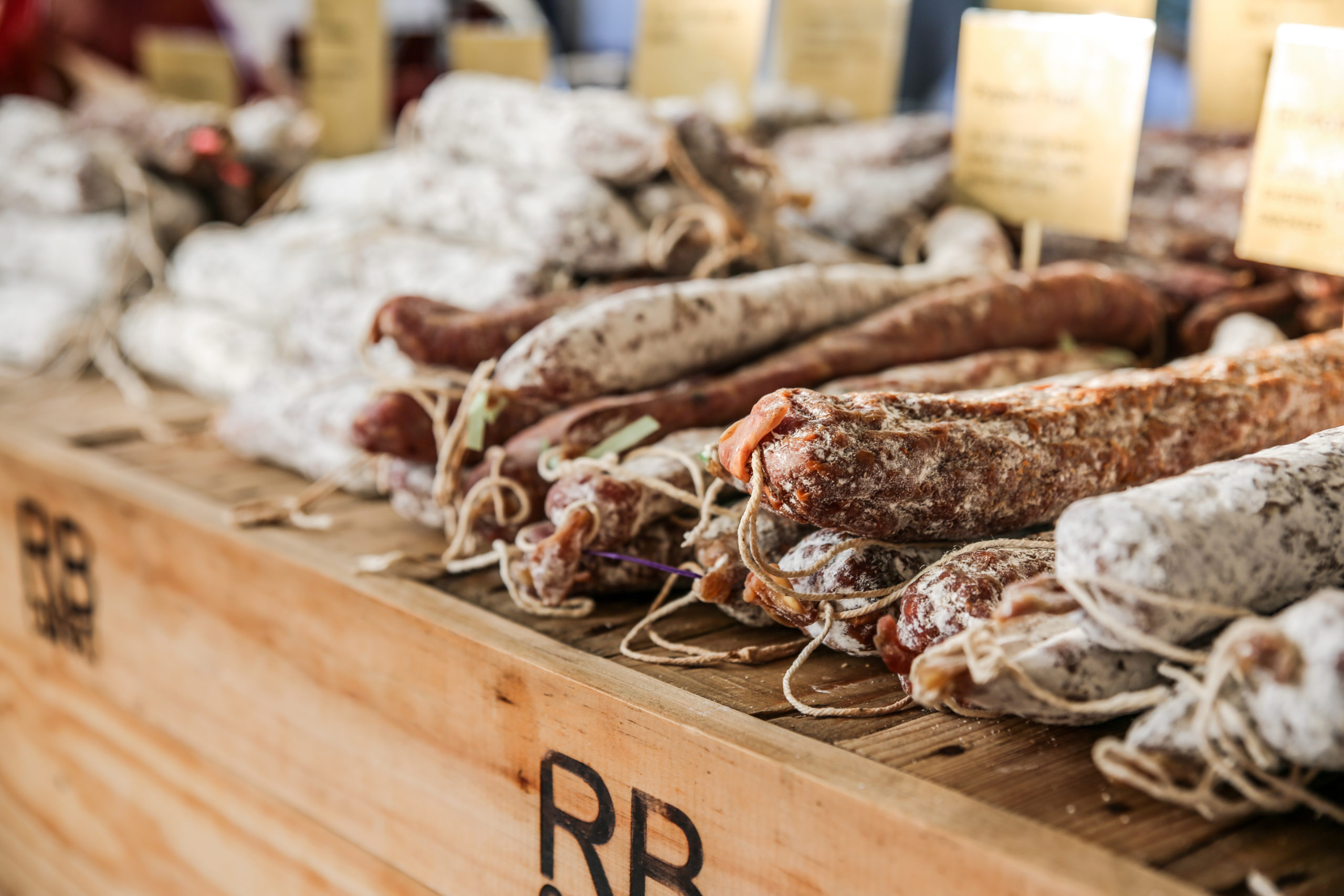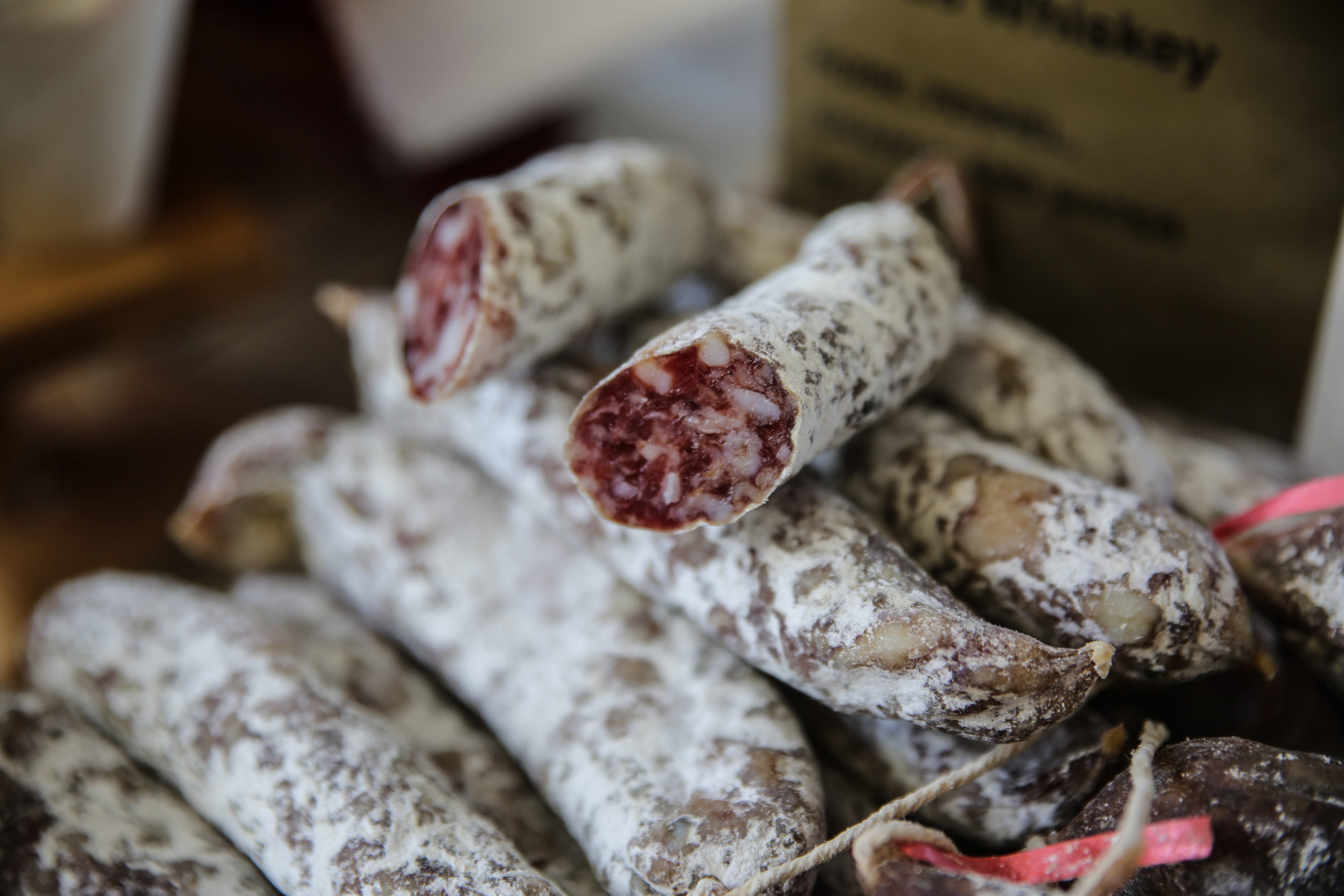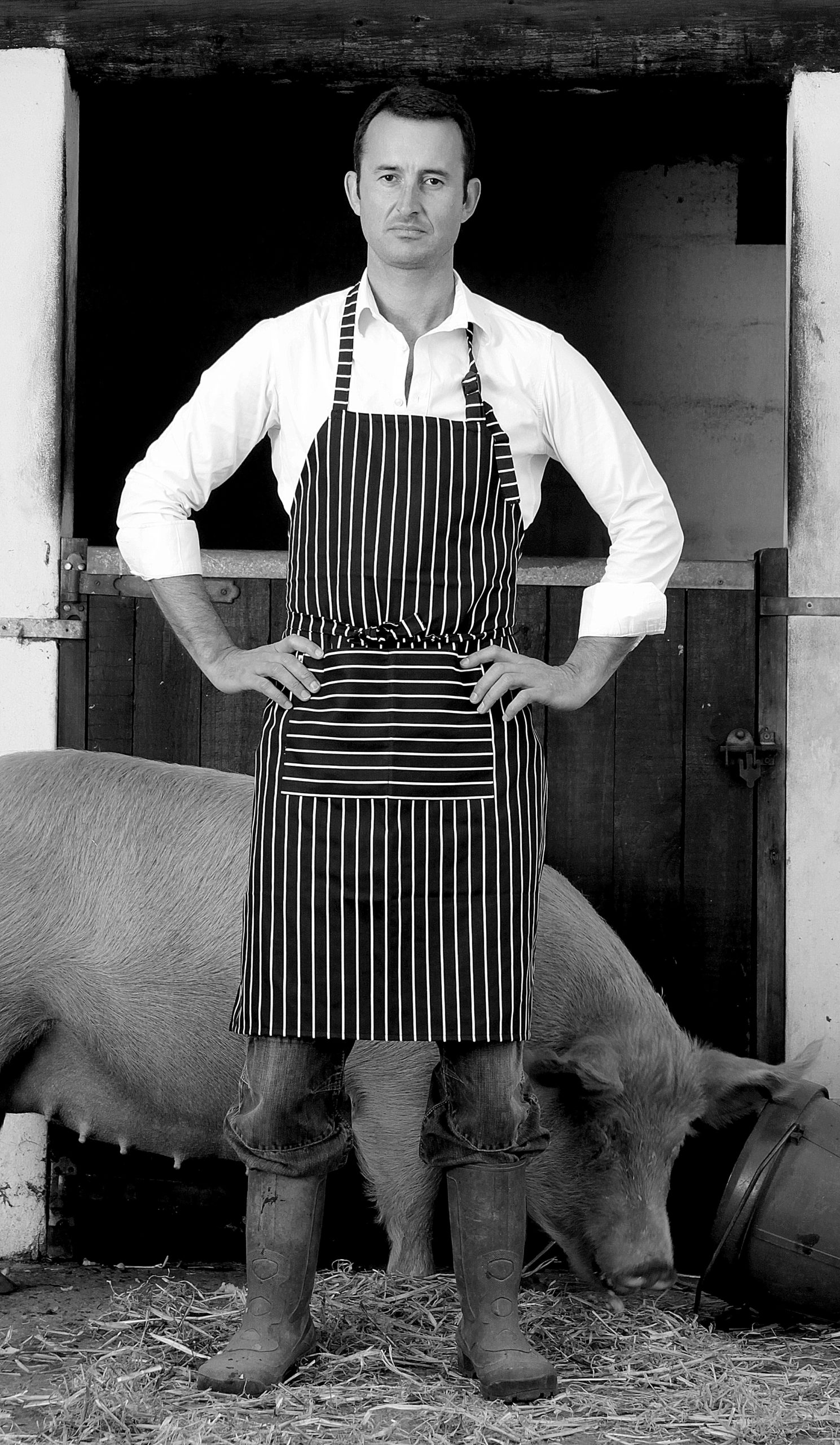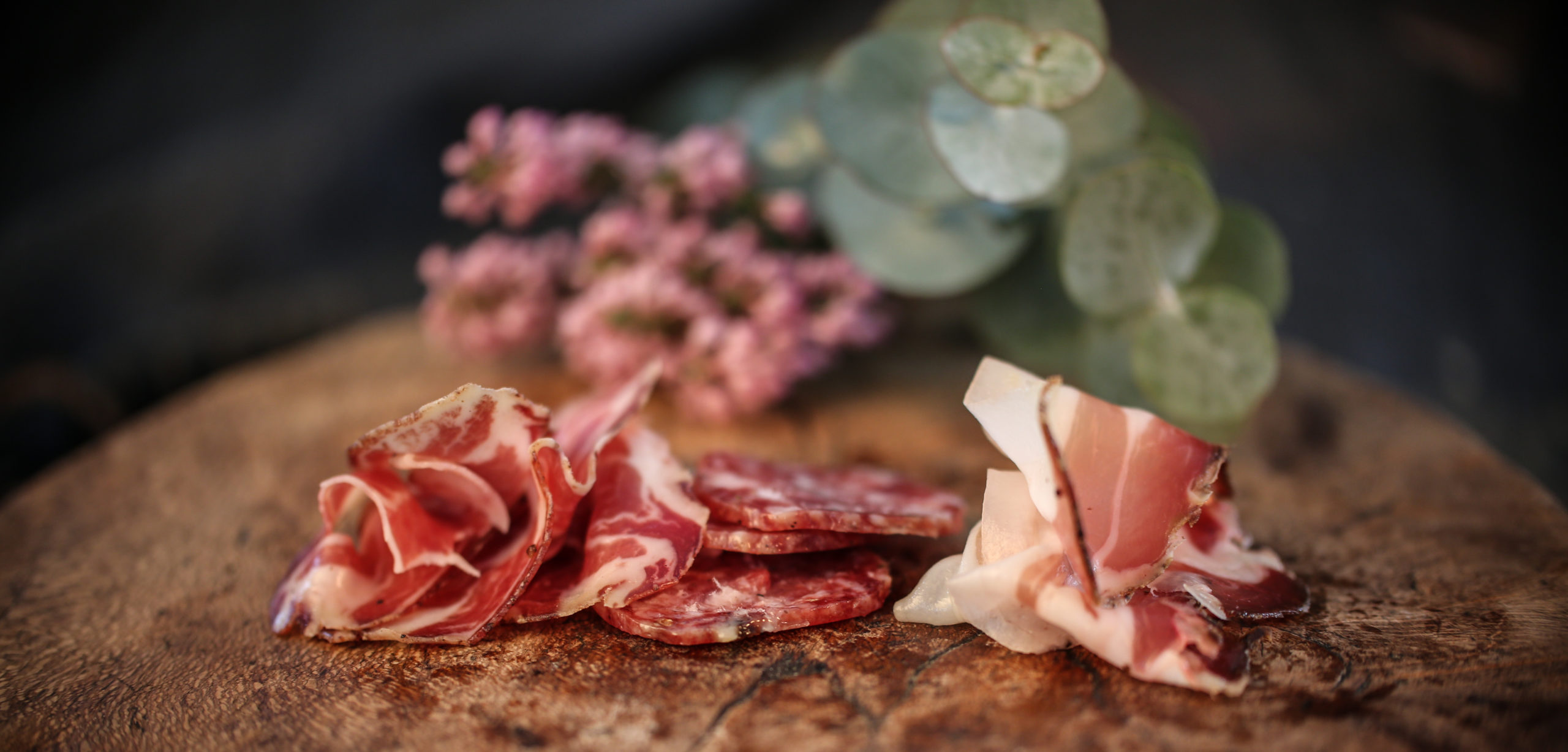WIZARD CURES
Richard Bosman, salt of the southern soil

For all the boards and platters you see on menus, charcuterie in South Africa is a specialist niche market, with a handful of local producers scattered around the country. Richard Bosman of Richard Bosman Quality Cured Meats is one of two in Cape Town using salt to cure meat. A centuries old method, it is the beginning of the process which sees an entire animal used with purpose.
Richard Bosman is one of the sweetest, nicest, kindest people you could hope to meet. Patient too. I’ve known him – and been familiar with his quality meat products – for many years but it’s been now, in 2020, when confinement prompted all manner of online and digital shopping, that we’ve had a lot more contact.
This is because Bosman has an app, and I have his cell number. Therefore, every time I have a question or a glitch, I send him a WhatsApp (never call, quelle horreur).
It could be anything from why I can’t put in the collection date I want, or why isn’t my password working, to I bought bratwurst ages ago because I’m pretty much working through the entire range, it’s been in the freezer and I’ve just realised I don’t know what to do with it.
“Pan fry or grill. Serve with mash, fried onions and sauerkraut. Or make the best hot dog of your life with mustard, fresh tomato and onions,” was the answer. While we’re at it, the frankfurters are fantastic and – wait for it – everything is gluten-free (except the pork pies). So unbelievable is this that I send Bosman repeated messages asking him if he’s absolutely sure about this.
No matter how dumb (or annoying, yes I’m aware) I think I am, Bosman always makes me feel better, and he never leaves me on read. The other thing that always makes me feel better is bacon, and Bosman’s got that covered too, as well as a host of other delicious meaty treats: prosciutto, pancetta, coppa, bresaola, hams, salamis, chorizo, things in jars…
It all gets made at a facility in Killarney Gardens, where whole pigs are bought in and every last scrap is used. It’s a way of honouring and respecting the animal, along with the very practical need to be profitable.
“The back leg we turn into prosciutto, and in that same style we take out the topside and rump and make a culatello – it’s like prosciutto but a smaller part of meat that you cut off the leg. It comes from a region in Italy called Zibello, which is famous for it,” said Bosman. “Or we make cooked ham, rosemary ham, cider ham, or gammon – all from the hind quarter.
“Some prosciutto has the bone in, and most have skin on. If we take the bones out we sell them to people who make stock.”
The little fillet muscle on the inside of the ribcage is a revelation; it can be beautifully cured and become almost a kind of biltong. In September 2020, there was a special offer of a free gift and the cured fillet was it. Never mind that I forgot the freebie was the reason I put in an order before the end of the month and when it arrived I WhatsApped Bosman to ask why it was in my delivery. Point is, it’s really delicious. Being of variable weight and therefore price, it’s way too complicated to put on the app but you can get it from the stall at Oranjezicht City Farm Market (OZCFM) at V&A Waterfront on Saturdays and Sundays.
“The loin and belly next to the leg give us back bacon – smoked or unsmoked, regular or thick cut – and streaky bacon mainly, and about 20% of pancetta, also from the belly,” said Bosman. Pancetta is fatty, like streaky bacon, and during the curing process he adds lots of herbs and garlic, bay leaf and juniper. “It’s an aromatic bacon-style product, great for pasta sauces or wrapped around lean cuts of venison.”
The shoulder, which has hard working muscle, is used for salami and sausage, and the bottom of the shoulder has the neck muscle – a “lovely round muscle, great marbling,” said Bosman. This is coppa, which is Italian for collar.

Richard Bosman makes a wide range of salamis – fennel, vino, saucisson sec – as well as pepper fuet and warthog fuet. (Photo: Supplied)
Then we get to the head. During a tour of HQ, Bosman showed me the pig carcasses which had recently arrived from Het Goedgeloof near Barrydale, and pointed out the colour – a deeper, darker shade than the pork chops you’ll find in the supermarket.
“We get the animals from Fairview and sometimes Oak Valley, and there is Buttons Farm in Piketberg. They’re all free range, big pigs,” said Bosman. “These are pigs that have been running around and been active, and their blood and muscle are oxygenated.”
A pig such as this takes about 18 months to “grow” while a commercial piggery pumps its livestock with hormones and steroids and sends them to market at about four months.
“When we started here in 2009, there was one farmer doing pasture-raised pigs; now there are four so it’s become easier to source good ethically reared meat which is important to me,” said Bosman. “If you put a cage reared commercial piggery animal next to one of ours, it’s chalk and cheese. The meat colour is different, the smell is different, and it’s soft and sticky. They get very stressed in those environments and can develop a condition called PSE (pale soft exudative).”
Which just sounds nasty.
If that’s a bit off putting, you don’t have to immediately don a sackcloth and join the vegans. The easier answer is to eat meat, but eat better meat – and less of it. Bosman doesn’t advocate a diet devoid of it, but is in favour of consuming it more ethically.
The choicest part of the head is (are?) the cheeks. I remember reading Kitchen Confidential and a few other books by Anthony Bourdain and marvelling at how much detail he could recall of his first oyster (I’ve got nothing, my memory is all but useless), and out of all that, the detail I’ve filed away for easy access in the right situation is that somewhere along the line he said the cheeks are the best part of any animal, or fish. Subsequent experience has borne this out.

Chorizo can be eaten just like this, or added to various dishes. (Photo: Supplied)
At Richard Bosman Quality Cured Meat the cheeks are used to make guanciale, which is simply marvellous. It’s one of the products Bosman refused to give up even though initially it barely sold at all. “I couldn’t give it away,” he said. One fine day in 2014 or thereabouts, Italian chef Andrea Volpe (now at Pesce Azzurro in Woodstock) called Bosman to enquire about guanciale, so off Bosman went to see him. There was some wine and the next thing Volpe had made a carbonara pasta to say thank you. “No cream, garlic, parmesan, and with the egg,” recalled Bosman fondly.
Nowadays it’s as popular at the market as it is with restaurateurs, and for that I’m eternally grateful because it’s one of my favourite indulgences.
The rest of the meat from the head is used to make terrines (market, not yet on the app but I’ve urged Bosman to do that – no pressure, Richard), and everything else is cooked for a long, long time. The result is a concentrated gelatinous stock that gets poured into the pork pies to fill the space that happens around the meat during baking.
Other trimmings go into sausages, and offcuts find their way into things in jars, like bacon salt or bacon relish. “I get bored at work so I can do fun things like that,” smiled Bosman. When I got a jar of the bacon miso caramel, a friend asked me what I would eat it with. “A spoon?” was my answer, duh.

Saucisson sec is a family of thick, dry-cured sausages in French cuisine. (Photo: Supplied)
What’s left? Oh yes, the skin. “We boil it and dehydrate it and then deep fry it in rendered pork fat – the lard which is too soft for sausages and salami – to make crackling.”
It’s a real labour of love, said Bosman, because it takes about three days but you can buy for a mere R20 a packet. “But what else do you do with the skin?” asked Bosman. Man has a point. And who doesn’t like crackling? No friends of mine, that’s for sure.
Bosman’s interest in charcuterie began while he was working for Woolworths, and went on business trips to Spain and Italy to source cured meats. When he left Woolies, he bought a little deli in Hermanus in 2004, selling typical deli products, including charcuterie. Walter Heller, who started Deli Spices, came to visit and said he could teach Bosman how to make all these products – if he was interested. “He trained as a fleisch meister in Germany, and came to SA about 50 years ago when he started a spice business,” said Bosman. “But he never lost the art of the block work and curing so one day we decided it would be a fun thing to do. Niels and Penny Verburg from Luddite Wine Farm gave me a pig – they were breeding at the time – and we did our first one together in 2007.”

Richard Bosman. He says he can smile, and that is true. Just not in this pic. (Photo: Supplied)
For a while it was a decent hobby, and the results weren’t too bad, said Bosman modestly. They were in fact good enough to make the decision to move back to Cape Town and open a full time, professional charcuterie business, in these very Killarney Gardens premises where he is still today, albeit larger.
What confidence! I remarked. “Confidence, foolishness, call it what you will,” said Bosman, adding that his romantic idea of producing entire legs of prosciutto and having a distributor sell them turned out to be far from the reality.
“Everyone wants presliced for a) convenience and b) portion control. Even the chefs don’t want to slice their own stuff,” said Bosman. Now two thirds of the staff slice meat and pack meat as opposed to making it. “It’s fine, we had to grow into it,” he said.
Free range pork is expensive, and Bosman makes European-style products not everyone understands or can pronounce (like guanciale). “It’s hard to find a distributor who can explain that to buyers, so you do it yourself. I’m useless at that. I can’t sell anything.”
Luckily, over the years, Bosman has developed a reputation so clients come to him. The market is great for business because people can see the range and ask questions. Then there is the new home delivery option. “It’s one of the good things that came out of Covid-19; it forced us into a direct-to-the customer model. It’s quite nice to interact directly with customers, who can write messages and give feedback. You’ve done lots of that,” he remarked.

Can’t make up your mind? Get a mixed selection in one pack. (Photo: Supplied)
Interestingly, bacon wasn’t one of Bosman’s early successes. It’s difficult to convince people to buy a lower weight of more expensive bacon until they see for themselves how much commercial bacon is bulked up with water. He tested it with the two cooked to the same crispness and the result was virtually the same weight. Bacon has a shorter production period which means quicker cash flow, which is attractive.
One night when Bosman and his clever wife Justine were returning from a wedding in Franschhoek, she said “we should open a bacon restaurant!” and Bosman said “brilliant idea!” and they didn’t mention it again. You know how it goes. Bacon On Bree was eventually born in 2015, in those heady days of foodie heaven in upper Bree Street, Cape Town.
“It was quite scary in the beginning … we had queues out the door. It was supposed to be a little bacon sandwich bar, nothing too complicated – come to the counter, order your sandwich and we’ll bring it to you – that sort of European self-service model, and no one understood it,” said Bosman. “We didn’t have waiters so we changed it to be a normal sit down service model.”
After four years, the landlord gave them notice and the couple took the concept to the OZCFM. Now, Justine runs the Bacon On Brie stall and Bosman said it’s the best thing that could have happened to them. The small menu has seven items, including the very sensible “Bowl Of Bacon” no explanation needed, the popular Harvey Specter from the restaurant, and the No 1, which Justine insisted I try – a ciabattini filled with prosciutto, fior di latte mozzarella and musky porcini cream. There was a bit of rocket for show.
Prosciutto’s flavour profile is salt, and it’s a miracle curing agent. “The beauty of what I do is the shelf life is long – months and months. The technique was designed thousands of years ago, long before refrigeration, to preserve meat,” said Bosman.

In his courses – soon to be available online – Richard Bosman demonstrates how to make several kinds of charcuterie. (Photo: Supplied)
You too can learn these magical arts; Bosman holds regular courses around the country. There is one happening on November 28 and 29, 2020 at Residence William French in Simon’s Town. Franck Dangereux from Food Barn in Noordhoek is making lunch on the Saturday and dinner is at Residence William French. The cost is R3,800, accommodation (optional) is R1,500 per night. Email [email protected] to book.
Other than that, this year’s courses – which are essentially everything Bosman learned from Heller back in 2007 – are all fully booked but Bosman has just finished filming an online course which should be available before the end of the year, and costs R999.
“It will be a series of downloadable lessons covering how to break down a pig and turn it into prosciutto, coppa, bacon, pancetta, sausages, salamis and chorizo,” said Bosman. The platform details are still being finalised but if you want more info, drop him an email: [email protected]
Another option is the Prosciutto Club. “It’s a slightly different course we offer where we teach you how to make a whole prosciutto and then we store it for you until it is ready. This saves you having to have space to cure it and you don’t have to worry about the drying conditions etc. It costs R3500,” said Bosman. DM/TGIFood
For more information, click here, or download the app from your store.





 Become an Insider
Become an Insider
Comments - Please login in order to comment.